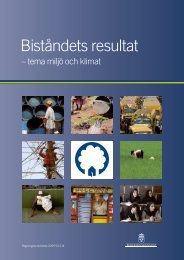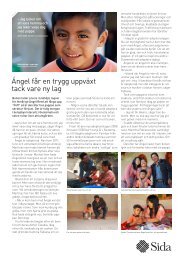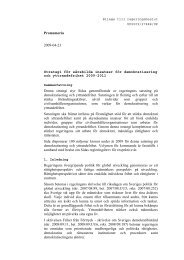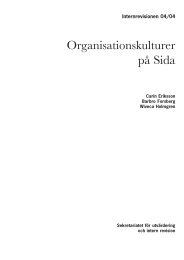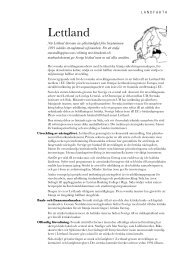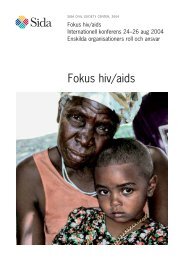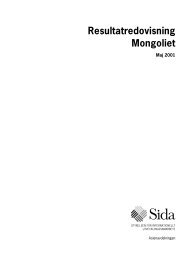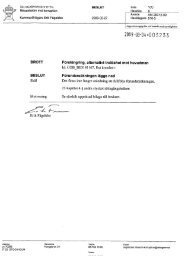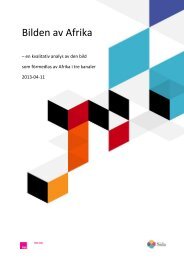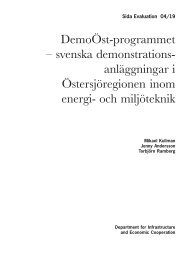Mid-Term Review of the AGIR Programme - Sida
Mid-Term Review of the AGIR Programme - Sida
Mid-Term Review of the AGIR Programme - Sida
Create successful ePaper yourself
Turn your PDF publications into a flip-book with our unique Google optimized e-Paper software.
2 F I N D I N G S<br />
2.5 IMPACT OF <strong>AGIR</strong><br />
2.5.1 Progress Towards First ’Outcomes’ Emerging from <strong>AGIR</strong><br />
The programme is in its third year. For <strong>the</strong> intermediary SCC, this is its second year<br />
<strong>of</strong> implementation. Some CSOs joined <strong>the</strong> programme in 2011. The likelihood <strong>of</strong> <strong>the</strong><br />
programme to produce <strong>the</strong> expected impacts depends on factors both inside and outside<br />
<strong>the</strong> scope <strong>of</strong> <strong>the</strong> programme. Inside <strong>the</strong> programme, <strong>the</strong> ability <strong>of</strong> CSO partners<br />
to absorb <strong>the</strong> given capacity streng<strong>the</strong>ning and <strong>the</strong> internalising <strong>of</strong> <strong>the</strong> approach <strong>of</strong> <strong>the</strong><br />
programme are key points for its success. Outside <strong>the</strong> scope <strong>of</strong> <strong>the</strong> programme is <strong>the</strong><br />
changing environment <strong>of</strong> development aid that has been heavily affected by <strong>the</strong> financial<br />
crisis and <strong>the</strong> challenges posed in <strong>the</strong> national Mozambican context, with <strong>the</strong><br />
natural resources boom and <strong>the</strong> risks and opportunities it represents for civil society<br />
capacity building.<br />
Capacity streng<strong>the</strong>ning within <strong>the</strong> <strong>AGIR</strong> programme <strong>of</strong> <strong>the</strong> CSO partners is on-going<br />
and training in areas such as administrative, financial and human management, results-based<br />
management, gender, human rights and fund raising are contributing to<br />
improve organisations’ internal capacities and to address important issues like gender,<br />
human rights, HIV/AIDS. Although <strong>the</strong>re are some challenges, such as adjusting <strong>the</strong><br />
gender training approach to <strong>the</strong> conditions <strong>of</strong> <strong>the</strong> partners, improving and consolidating<br />
internal governance, and adopting results-based management, <strong>the</strong> programme has<br />
good potential to succeed in attaining <strong>the</strong> objective <strong>of</strong> streng<strong>the</strong>ning organisations’<br />
internal capacity and eventually in creating <strong>the</strong> conditions for self-sustainability.<br />
Most <strong>of</strong> <strong>the</strong> contacted CSO partners have expressed <strong>the</strong>ir concern about <strong>the</strong> dramatic<br />
reduction <strong>of</strong> sources and opportunities <strong>of</strong> funding for civil society. The push <strong>of</strong> <strong>the</strong><br />
intermediaries to convince donors to join common funds in <strong>the</strong> context <strong>of</strong> good donorship<br />
- although a consistent and adequate approach to improve alignment and<br />
harmonisation - will also contribute to reduce <strong>the</strong> number <strong>of</strong> available sources <strong>of</strong><br />
funding. This implies that ei<strong>the</strong>r <strong>the</strong> idea <strong>of</strong> diversification <strong>of</strong> sources <strong>of</strong> funding has<br />
to be redefined – in terms <strong>of</strong> development partners/donors and non-donors sources –<br />
or additional ways <strong>of</strong> defining access to funding should be adopted. Alternatives to<br />
this range from a definition <strong>of</strong> a percentage <strong>of</strong> <strong>the</strong> GDP (Gross Domestic Product) to<br />
fund civil society, which in <strong>the</strong> current natural resources boom could be viable to<br />
some extent, to <strong>the</strong> identification <strong>of</strong> non-traditional or new donors, for example, private<br />
companies. The training on fund-raising provided to partner organisations can<br />
help <strong>the</strong>m to devise ways <strong>of</strong> diversifying <strong>the</strong>ir sources <strong>of</strong> funding; but <strong>the</strong> success <strong>of</strong><br />
this endeavour also depends on a strategic and creative vision and <strong>the</strong> management <strong>of</strong><br />
civil society organisations.<br />
Although <strong>the</strong> intermediaries have been very active in lobbying for core funding, in<br />
general, under <strong>the</strong> current globalised financial crisis it seems unlikely to expect overall<br />
improvement in funding or overall diversification in funding. The <strong>AGIR</strong> programme<br />
is contributing to foster <strong>the</strong> adoption <strong>of</strong> mechanisms for common funding for<br />
CSO partners. In some cases, this stems froms <strong>the</strong> initiative <strong>of</strong> intermediaries (e.g.<br />
IBIS and MASC), in o<strong>the</strong>rs from <strong>the</strong> initiative <strong>of</strong> well-established CSO partners in<br />
supporting common pool funding mechanisms for strategic plans (eg. Nwety, WLSA<br />
53




